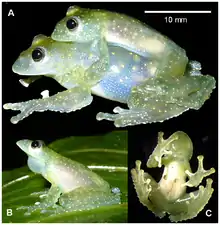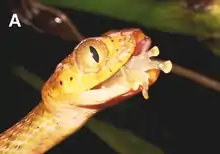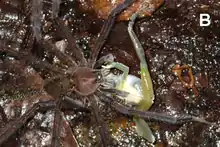Cochranella mache
Cochranella mache, also known as the Mache glassfrog or Mache Cochran frog, is a species of frogs in the family Centrolenidae. It is found in the lowland forest and eastern slopes of Cordillera Mache–Chindul in the Esmeraldas Province, northwestern Ecuador, and in the western foothills of the Cordillera Occidental in Colombia (Antioquia, Chocó, and Valle del Cauca Departments).[3][4][5]
| Cochranella mache | |
|---|---|
 | |
| Top: An amplectant pair. Bottom: A calling male.[1] | |
| Scientific classification | |
| Kingdom: | Animalia |
| Phylum: | Chordata |
| Class: | Amphibia |
| Order: | Anura |
| Family: | Centrolenidae |
| Genus: | Cochranella |
| Species: | C. mache |
| Binomial name | |
| Cochranella mache Guayasamin and Bonaccorso, 2004 | |
Description
Adult males measure 22–26 mm (0.87–1.02 in) and females 26–33 mm (1.0–1.3 in) in snout–vent length. The dorsum is green with numerous, small yellow dots. The upper lip has a narrow white line. The ventral surfaces of the extremities as well as the gular region are greenish blue. The iris is white and has fine black reticulations and a golden ring around the pupil.[4]
Reproduction
The males call in vegetation overhanging rivulets, typically in the midstory vegetation some 2–10 m (6 ft 7 in–32 ft 10 in) above ground. The call consists of two pulses lasting about 0.04 seconds and about 0.01 second apart, and with the dominant frequency of 5410 Hz. The amplexus is axillar. Fecundity of a 33 mm long female is about 30 eggs.[1]

Habitat and conservation
Its natural habitats are seasonal evergreen foothill forests[2] and sub-Andean forests at elevations of 43–1,030 m (141–3,379 ft) above sea level.[4][5] The Ecuadorian population is under significant pressure from logging.[2]
References
- Ortega-Andrade, H. Mauricio; Rojas-Soto, Octavio; Paucar, Christian & Salice, Christopher Joseph (5 December 2013). "Novel data on the ecology of Cochranella mache (Anura: Centrolenidae) and the importance of protected areas for this critically endangered glassfrog in the Neotropics". PLoS ONE. 8 (12): e81837. doi:10.1371/journal.pone.0081837. PMC 3855356. PMID 24339973.
- IUCN SSC Amphibian Specialist Group (2020). "Cochranella mache". IUCN Red List of Threatened Species. 2020: e.T61764A85908989. Retrieved 24 December 2020.
- Frost, Darrel R. (2020). "Cochranella mache Guayasamin and Bonaccorso, 2004". Amphibian Species of the World: an Online Reference. Version 6.1. American Museum of Natural History. doi:10.5531/db.vz.0001. Retrieved 30 July 2020.
- Guayasamín, J. M.; et al. (2018). Ron, S. R.; Merino-Viteri, A. & Ortiz, D. A. (eds.). "Cochranella mache". Anfibios del Ecuador. Version 2019.0. Museo de Zoología, Pontificia Universidad Católica del Ecuador (QCAZ). Retrieved 30 July 2020.
- Acosta Galvis, A. R. (2020). "Cochranella mache Guayasamin and Bonaccorso, 2004". Lista de los Anfibios de Colombia: Referencia en linea V.10.2020. Retrieved 30 July 2020.

